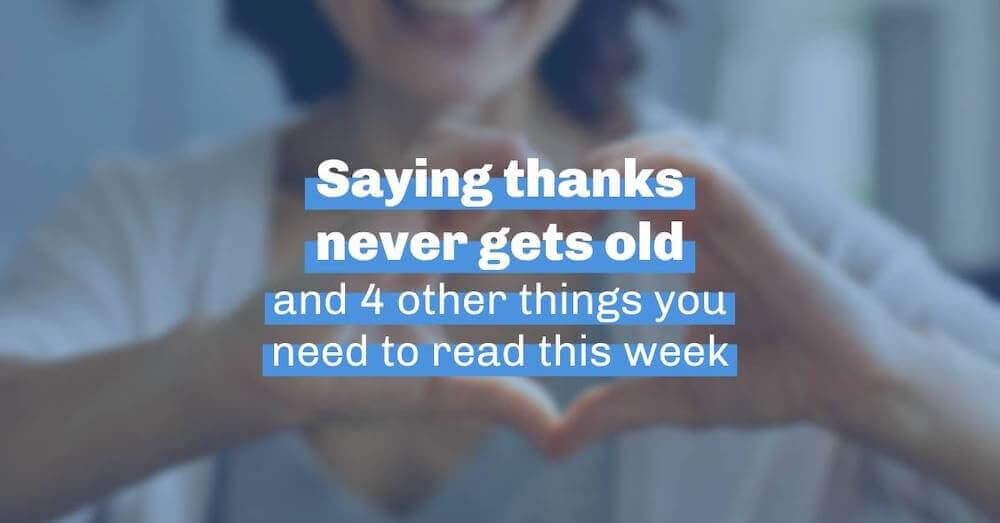
by Ian Haisley | Apr 16, 2021 | +Good Newsletter
This list originally appeared in +good — our weekly round-up of the articles, tools, books, videos, and stories we can’t stop talking about. If you aren’t already subscribed, sign up for free!
1. Saying 💬 thanks never gets old.
Being thanked is different from feeling thanked — and mastering the attitude of gratitude is what separates the good from the great when it comes to donor relations. Think your thanks need an upgrade? Don’t worry, we’ve got seven ways to express gratitude that will give your donors those fuzzy feelings.
Easy ways to thank your donors. [Swell + Good]
2. Is your content 🕶️ on trend?
Wish you had unlimited time and money to jump on every single trend you see? Us too! But we’ve learned (sometimes the hard way) to be picky about what we invest in. These tips from Contently help you navigate the trends of 2021 to decide which ones work best for your goals.
Content marketing trends that matter most. [via Contently]
3. You read 📖 this, right?
If you’re still reading, learn why others might have looked over these next few sentences. The Startup suggests that using subheaders could not only improve your SEO but hold onto your reader’s attention. When drafting the copy for your next fundraising campaign, follow their advice: Start with too many subheaders — then cut back. Your most important message should be the easiest to read.
We’re guessing you read this, too. [via Medium]
4. Are Facebook ads worth it?
What percentage of Americans log in to Facebook each day? If you guess was nearly three-quarters, you’re right — 68% of Americans look at the site on a daily basis. And if your audience is there, you should be there, too. Get started with Facebook Ads (or take your advertising to the next level) with these helpful hints. From detailing your Facebook ad budget to recommending the metrics to track, this guide does the research for you.
Get into the ad business. [via Neil Patel]
5. Heat up your cold 🥶 subscribers.
Almost 20% of your average nonprofit’s donations come from email lists, so if your newsletters and campaign emails are feeling stale, it’s time to hit refresh. Learn best practices for scrubbing your subscriber list, discover the secrets of an effective email cadence (hint: you should send more frequently than you do), and receive a free license to break the email marketing rules your internship taught you.
Mix up your email game. [via Marketing for the Modern Nonprofit]
This issue of +good was written and produced by Allison Kooser, Ian Haisley, Sydney Bartlett, Lindsey Lincoln, and Katie Powers.

by Sydney Bartlett | Apr 5, 2021 | Donor Engagement, Year-End
It may seem like your year-end campaign was just a few months ago, but, in reality, your year-end campaign is just a few months away! Don’t wait for the weather to turn cold before you begin to prepare for year-end. Get yourself ready now with these five recommendations guaranteed to save a few headaches (and enhance your fundraising!) down the line.
Review your donor thank you process and set yourself up for your next ask.
Stewardship doesn’t wait for year-end. Your supporters want to feel appreciated and involved in your organization all year long, and reviewing (and revamping!) that thank you process now will maximize your future asks. Fronstream reports that “80% of [first-time] donors say a simple ‘thank you’ would convince them to make a second donation.” Guidestar writes that a failure to acknowledge gifts is one of the primary reasons donors stop giving.
We’ll give you a few quick do’s and don’ts:
Do thank your donors quickly!
The Modern Nonprofit recommends that, ideally, donors receive a thank you within 24 hours of a gift but no later than one week.
Do thank your donors often!
Creating multiple touch points with your donors throughout the year is key. Alexander Haas suggests six curated interactions with donors throughout the year, ranging from thank you cards to newsletters and personal invitations.
Don’t make it all about your organization
Thanking your donors is about emphasizing their impact. Guidestar proposes a “3:1 ratio of ‘You’ vs. ‘We’” language.
Don’t use it just to ask for something else
Bloomerang stresses that your thank you is “not the time to solicit another gift.” Gratitude for gratitude’s sake is always a good idea.
Setting a top-notch thank you process in motion now will build the foundation you need to make a confident ask at the end of this year.
Sharpen up and simplify your donation forms.
Donating to your organization should be easy and appealing. The less complicated it is to make a gift, the more likely it is that your supporters will give—now and at year-end. Classy underscores the importance of clear donor forms: “It’s not about making people act without thinking, it’s about making it easy to do the right thing.”
Simplifying your donor forms doesn’t have to be hard, either. Keep your form short by reducing excess language and refraining from long-winded sentences. Don’t give your donor more information than they need to make their gift. Donorbox emphasizes minimalism and warns against clutter on donation forms while offering Code for America and Shanti Bhavan Children’s Project as examples for easy, effective donor forms.
The fewer barriers that your supporters run into while making a gift, the more likely it is that you’ll see that gift in your organization’s bank account. By the time year-end rolls around, your donors will thank you for a clear-cut avenue to gifting—and you’ll be thanking yourself (and them, of course!), too.
Still looking for a simple, affordable, convenient, and effective way to collect online gifts? We’ve got you covered! Swell is an online giving tool that makes it easy and awesome to raise money online. To learn more and get set up, contact us.
Clean up your lists.
Knowing who you’re inviting to make a year-end gift—and where you’re sending your request—can make or break your campaign. Whether it’s a direct mail or email campaign, accurate donor information is key to getting the right message to the right supporters. A clean donor list is a responsive donor list, according to Get Fully Funded. Start by creating (and using!) data entry rules, marking donor preferences, and finding and merging duplicate records. If possible, fill in missing holes in donor data by reaching out to them now so that you’re ready to talk to them across multiple channels in a few months.
With up-to-date donation and contact information, segmenting your year-end lists and creating your mail merges will be seamless. Whether you’re sending an email or dropping letters in the mail this winter, The Modern Nonprofit recommends practicing data hygiene now to save time and money in the future.
Tell your donors what their 2020 year-end gift made possible.
If you want the donors who gave to last year’s campaign to give again, they’ll need to know that their past gift made a difference. According to Candid, donors want to know more about your organization’s work than your needs, so it’s important to share impact stories all year long. Likewise, Causevox says that donor communication needs to go beyond the thank you. Supporters should know the impact of their gift. Otherwise, they’ll end up with the 22% of donors that stop giving due to poor communication.
Start telling your supporters what last year’s campaign is doing for your organization in order to build confidence in your work and lay the foundation for future gifts.
Run an acquisition campaign to build your list of leads now.
Diversifying your funding sources is critical to fostering a sustainable organization. Beginning your search for new donors well ahead of year-end gives you the time to implement key stewardship practices prior to making your ask. Donorbox offers 15 techniques to boost your donor acquisition, including relying on the networks of your current donors, goal-setting, and peer-to-peer fundraising.
Many of the tools needed to run a stellar donor acquisition campaign are in your back pocket. Network for Good recommends using the data you already have to get started, and Salsa says to stay close to home when it comes to your campaign. Many of your best prospects are closer than you might believe (think: volunteers!), and when year-end comes around, you’ll have new names (with some familiar faces) on your list.
If you’ve made it this far, you’ve already jump-started your end-of-year campaign. Implementing these five tactics now will position your next year-end to be the best one yet.


